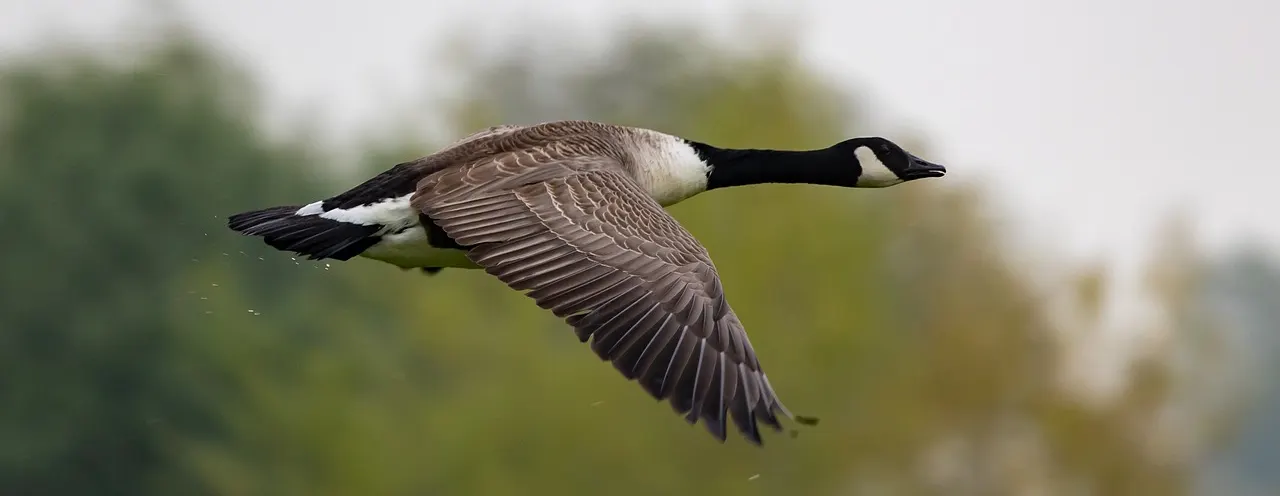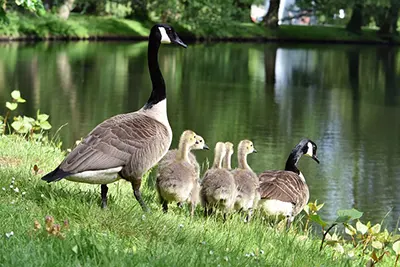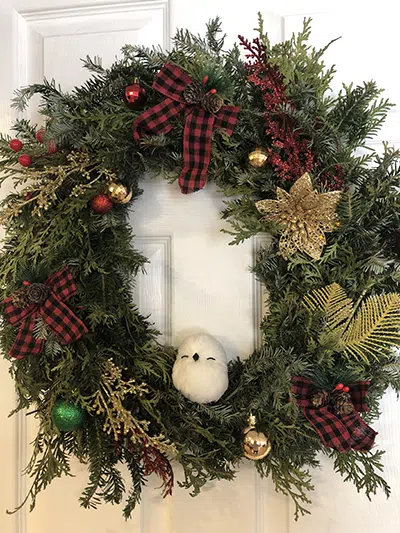Ah, the familiar and long awaited sound of honking on a cool morning signaling that spring has arrived! :) Many of us Northern folks eagerly await the arrival of Canada Geese in Ontario. But, what exactly is a Canada Goose Bird?

Identifying Canada Geese
Canada geese (Branta canadensis) are large birds, comfortable on both, water and land. While many migrate south before the winter, there is a growing number of Canada geese sticking around, even in colder regions.
Physical Characteristics
The bird, Canada Goose, is large and sports large webbed feet, a black head and bill, a long black neck and a very distinct white chin strap. It belongs to the Branta genus of geese, which contains species with a large amount of black feathers. The body of a Canada Goose is mostly brown It can weigh as much as 15lbs with an impressive wingspan of up to 6 feet.
Distinctive Honk and Behavior
The ‘honk’ is a familiar Canada Goose bird sound. It is a fairly deep, guttural bird call. Geese use it to announce or proclaim their territory and to communicate with each other.
Habitat and Distribution
Native Range
Canada Geese are found all over North America. Their natural habitat includes a diverse range of ecosystems, including wetlands, marshes, lakes, rivers, and agricultural lands.
Urban Adaptation
Canada Geese are particularly drawn to lawns for two reasons: they can digest grass, and a manicured lawn allows for early predator detection and the protection of their nests. That’s why we see them in abundance in parks, airports, golf courses, and other areas with expansive lawns.
Migratory Patterns
Canada Geese that breed in the High Arctic fly all the way to the southern United States for winter.
V-Formation Flight
Geese fly in V formation to conserve their energy during long migratory journeys. Each bird takes advantage of thermal air currents and the slipstream created by the bird in front. At times, you can observe one side of the V being longer than the other; this is believed to happen when there are crosswinds. The amount or strength of wind can also determine how wide or narrow the V-shape is.
Because the ‘lead’ is the most challenging place to be, different birds will take the lead during long flights and then be relieved from duty.
Seasonal Movements
Aside from their remarkable journeys beginning in the fall, individual Canada Geese from most populations embark on annual northward migrations after breeding. There, they take advantage of vegetation in an earlier state of growth to fuel their molt. Even geese not migrating south for the winter, will move north in late summer to molt.
Canada Goose Behavior
Canada Geese are known to be a formidable force, especially when protecting nests or offspring. But did you know that they can also display compassion? When a bird falls out of formation because of disease or injury, it will head towards the ground. 2 other geese will follow and stay with the ill fated bird until it either is able to continue, or die. They will then set out to catch up with their flock.
Social Structure
Canada Geese are extremely social. The only time they may separate from their flock is when they are nesting. They will rejoin and migrate in their large flock.
Aggressive Tendencies During Nesting Season
Like any parent, anywhere, geese are vigilant defenders of their young. Since the female is mostly in charge of building the nest, laying the eggs, and incubating them, Father Goose stands on guard. If he deems you too close and becoming a threat, he may honk, hiss, lower his head and spread his wings in an aggressive posture.
Fun Facts About Canada Geese
 Above, we talked about an aggressive father or father-to-be coming at you. Here’s what you should do. Don’t turn and run. He will likely chase you. Instead, make eye contact and slowly side step and back away. Do this until his posture relaxes.
Above, we talked about an aggressive father or father-to-be coming at you. Here’s what you should do. Don’t turn and run. He will likely chase you. Instead, make eye contact and slowly side step and back away. Do this until his posture relaxes.
Lifelong Partnerships
Geese mate for life. ‘Til death do you part. Around the age of 2 years old, boy meets girl (or the other way around) and falls in love. If one of them perishes, the other will find new mate.
Out with the Old
To keep their feathers in tip top shape, Canada Geese shed ALL feathers once a year. This is called molting. The feathers of the head and body are molted gradually over a period of months, but feathers of the wings are shed all at once in late summer. During this time, geese are grounded for three to five weeks.
Contact Hawkeye for Expert Canada Goose Control
Is your lawn or pond being desecrated by Canada Geese? Can’t go anywhere without stepping in goose poop? Call us to discuss your options. We have developed a number of custom solutions to convince geese to relocate from your property to elsewhere. Hawkeye Bird & Animal Control has been at the forefront of Bird and Wildlife Management Solutions for well over 30 years.














